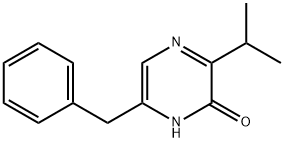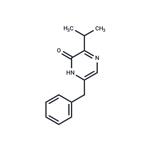Description
Aureusimine B, also known as phevalin, is a natural pyrazinone produced by certain fungi and by
Staphylococcus spp., including
S. aureus. Its synthesis appears to be initiated by a conserved nonribosomal peptide synthetase that creates a dipeptide (phenylalanine-valine) aldehyde, which then undergoes cyclization and oxidation. Aureusimine B inhibits calpain in a casein hydrolysis assay (IC
50 = 1.3 μM), contributes to
S. aureus infection in mice, and alters human keratinocyte gene expression.
Uses
Aureusimine B is a novel small molecule isolated from S. aureus as one of a pair of related metabolites controversially identified as virulence factors in the pathology of Golden Staph. Aureusimine B
has also been reported as an inhibitor of the protease, calpain.
Uses
Aureusimine B (phevalin) is a small molecular weight monoketopiperazine formed non-ribosomally by the fusion of phenylalanine and valine. Aureusimine B was isolated from S. aureus in 2010 as one of a pair of related metabolites, controversially identified as virulence factors in the pathology of Golden Staph. Aureusimine B is also an inhibitor of the protease, calpain.
Definition
ChEBI: Phevalin is a member of the class of pyrazinones that is pyrazin-2(1H)-one substituted by an isopropyl and benzyl groups at position 3 and 6, respectively. It is a natural product found in Staphylococcus aureus that inhibits calpain in a casein hydrolysis assay (IC50 = 1.3 muM), contributes to S. aureus infection in mice, and alters human keratinocyte gene expression. It has a role as a bacterial metabolite and a calpain inhibitor. It is a member of benzenes and a pyrazinone.

